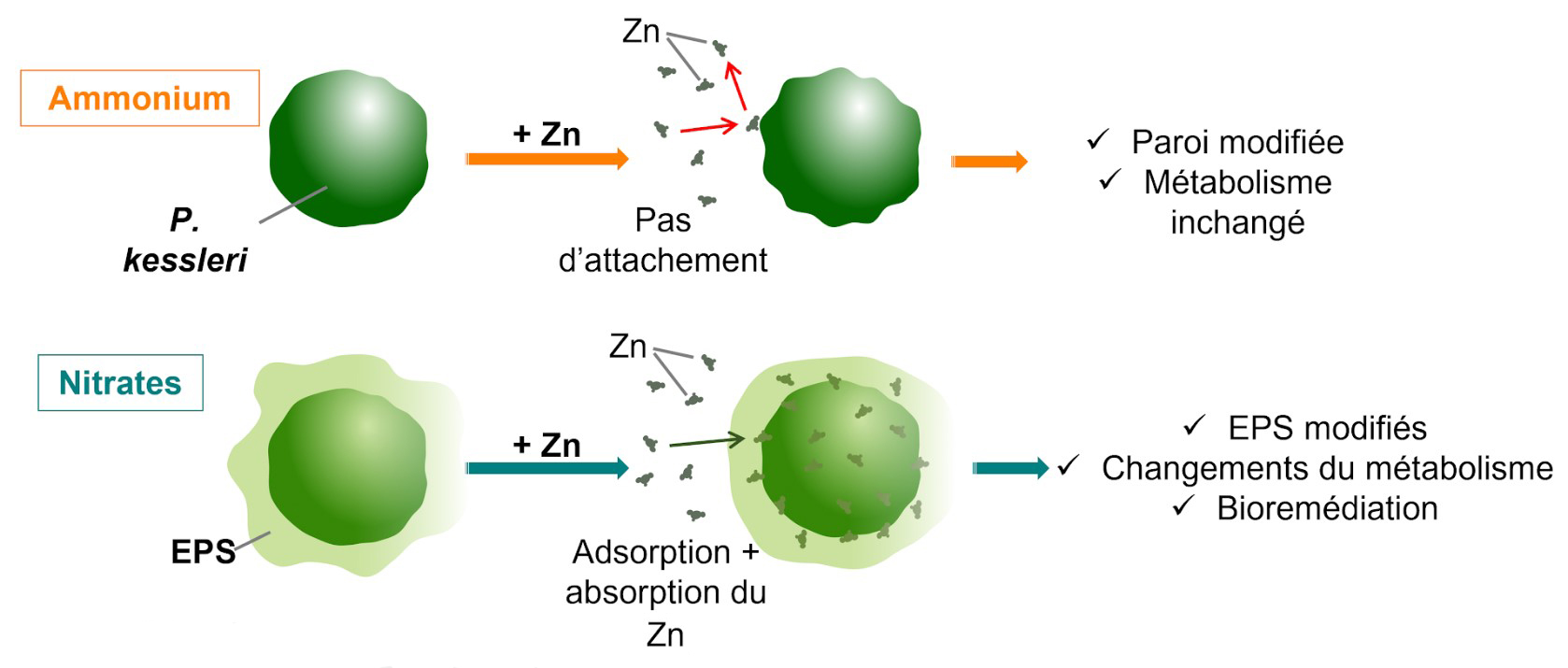Follow us on Google News (click on ☆)
Using an atomic force microscope, researchers demonstrated the influence of the nitrogen source in water on the molecular process behind zinc removal. These findings, which offer promising prospects for bioremediation applications, have been published in Environmental Pollution.

Schematic representation of the zinc remediation mechanism by [i]Parachlorella kessleri microalgae.
In the presence of ammonium nitrogen, the cell does not capture zinc.
In the presence of nitrate nitrogen, the cell secretes extracellular polymeric substances (EPS), which strongly interact with zinc.
© TBI[/i]
Microalgae have demonstrated their ability to clean the environment, particularly by removing heavy metals from polluted water. However, until now, the molecular mechanism behind this removal process was poorly understood. To promote the development of bioremediation techniques using microalgae, a team from the Toulouse Biotechnology Institute (TBI, CNRS/INRAE/INSA Toulouse) studied how a microalga, Parachlorella kessleri, sampled from a polluted river in Argentina, manages to remove zinc.
The study was conducted in collaboration with the Laboratory for Analysis and Architecture of Systems (LAAS-CNRS), the Process Engineering – Environment – Agri-food laboratory (GEPEA, CNRS/Nantes University/Oniris Nantes), and Argentine researchers from the General San Martin University.
In river waters polluted by industrial or agricultural effluents, nitrogen can be present in the form of either nitrate or ammonium. Researchers investigated how the behavior of these microalgae varies depending on the nitrogen source in water. The primary tool used for the study was the atomic force microscope (AFM), which measures the roughness and nanomechanical properties of the cell surface, as well as the strength of interactions between cell surfaces and surrounding chemical species.
The study first revealed that only cells cultivated with nitrate produced extracellular polymeric substances (EPS), macromolecules secreted by microalgae under certain cultivation conditions. Microalgae cultivated with ammonium did not produce EPS. AFM force spectroscopy experiments confirmed the strong binding of zinc to EPS in nitrate-cultivated cells, whereas interactions were weaker or absent in ammonium-cultivated cells.
Exposure to zinc also altered the roughness and nanomechanical properties of the cell surface. Furthermore, Raman spectroscopy revealed that microalgae exhibited different metabolic responses (such as the production of chlorophyll, carotenoids, and lipids) depending on the nitrogen source, with nitrate-cultivated cells showing altered profiles after zinc exposure.
These findings highlight the critical role of metal adsorption by EPS in the removal of zinc by P. kessleri cells. Regulating nitrogen sources could therefore stimulate EPS production, paving the way for promising bioremediation applications. The research partners are continuing to explore the potential of microalgae, with studies now focusing on other emerging pollutants: antibiotics from livestock farming, which are difficult to remove in wastewater treatment plants, and microplastics.
References:
Investigating the role of extracellular polymeric substances produced by [i]Parachlorella kessleri in Zn(II) bioremediation using atomic force microscopy[/i].
Victoria Passucci, Ophélie Thomas-Chemin, Omar Dib, Antony Ali Assaf, Marie-José Durand, Etienne Dague, Maria Mar Areco, and Cécile Formosa-Dague.
Environmental Pollution, December 2024.
https://doi.org/10.1016/j.envpol.2024.125082
Article available in the open archive database HAL